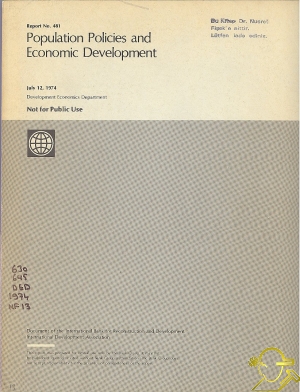Population Policies and Economic Development
İÇİNDEKİLERCHAPTER 1RECENT DEMOGRAPHIC TRENDS AND FUTURE PROSPECTS RECENT POPULATION GROWTH FIGURE 1 Mortality trends and prospects Recent Fertility Trends Income and Fertility Demographic Factors Affecting Fertility Changes in Marital Fertility Population Growth and Urbanization Future Growth Prospects Conclusion CHAPTER 2 THE EFFECT OF POPULATION GROWTH ON ECONOMIC DEVELOPMENT Economic Effects of Population Growth Effect of Population Growth on Income Per Head Population Growth, Investment, and Employment Population Growth and Personal Savings The Composition of Expenditure Education Employment The Effects of Population Growth on Income Distribution Population, Land, and Natural Resources Conclusions CHAPTER 3 THE EFFECT OF ECONOMIC DEVELOPMENT ON FERTILITY The Demographic Transition Correlates of Recent Fertility Levels The Process of Fertility Decline Age and Incidence of Marriage Marital Fertility Effect of Infant and Child Mortality Conclusion TABLE OF CONTENTS CHAPTER 4 POLICIES TO REDUCE FERTILITY IN DEVELOPING COUNTRIES National Policy Positions Abortion Present Distribution of the Population of the World by Policy Type Growth of Antinatalist Policies International Policies Worldwide Practice and Expenditure Patterns Conclusion CHAPTER 5 CHAPTER 6 PERFORMANCE OF FAMILY PLANNING PROGRAMS Measures of Program Performance Impact on Fertility Users versus Acceptors Program Acceptors Characteristics Conclusion INCENTIVES AND DISINCENTIVES FOR FERTILITY REDUCTION Incentives to Reduce Marital Fertility Economic Considerations Administrative Considerations Amounts and Conditions of Payment Experience Incentives for Other Purposes Disincentives Conclusion CHAPTER 7 THE FAMILY PLANNING DELIVERY SYSTEM Providing Information and Recruiting Acceptors Mass Media Informal Personal Contact Program Field Staff The Delivery of Services Facilities Characteristics of Management Program Evaluation Family Planning and Health Services The Location of Central Decisionmaking Health Role of Field Staff The Postpartum Approach Conclusions CHAPTER 8 CONCLUSIONS: THE DESIGN OF POPULATION POLICIES Population Growth Objectives Effectiveness of Policy Instruments New Programs and Projects ANNEXES ANNEX A: THE RELATIONSHIP OF THE SIZE DISTRIBUTION OF INCOME TO FERTILITY, AND THE IMPLICATIONS FOR DEVELOPMENT POLICY ANNEX B: THE RELATIONSHIP BETWEEN PROGRAM INPUTS, SOCIO-ECONOMIC LEVELS AND FAMILY PLANNING PERFORMANCE: A REGRESSION ANALYSIS ANNEX C: STATISTICAL ANNEX NOTLARDocument of the International Bank for Reconstruction and Development International Development Association   |



